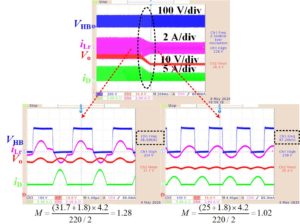A Resonant Frequency Tracking Technique For LLC Converters Based DC Transformers
Authors: Yuqi Wei, Quanming Luo, Alan Mantooth
Extended Abstract:
Large circulating current and reactive power exist for the LLC / CLLC converter in the case that f s < f r , where f s is the switching frequency and f r is the resonant frequency; on the other hand, in the scenario of f s > f r , the switching losses for both primary and secondary semiconductor devices are increased due to the large turn-off current and high di / dt related reverse recovery issue, respectively. When operating at the natural resonant frequency of inductor and capacitor or f s = f r , the regulation capability for LLC / CLLC converter is lost since the voltage conversion ratio is constant. This application of the LLC is known as a DC transformer (DCX), which has been widely adopted in energy storage systems as an interconnection between different units. However, due to the variation of circuit parameters, the switching frequency is different from the resonant frequency, which results in converter efficiency degradation and loss of output voltage regulation capability for two-stage applications.
In this article, by sensing both the output and input voltage, the converter voltage conversion ratio is computed on-line. Based on the comparison result between the calculated gain and unity, the switching frequency is adjusted accordingly and resonant frequency tracking is achieved. In addition, a multiple frequency adjustment step strategy is proposed to improve the tracking speed. Various scenarios are emulated in the experiment part to examine the effectiveness of the solution.
Experiment videos are also uploaded as multimedia to demonstrate the effectiveness of the proposed strategy. The benefits of the proposed strategy are: 1) the strategy is simple; 2) it can work in all scenarios, both below and above the resonant frequency region; and 3) it can be applied for all different structures.

This research work and the authors are associated with the UA Power Group in the Department of Electrical Engineering at the University of Arkansas, Fayetteville (https://electrical-engineering.uark.edu/index.php). For more information on our research projects, centers of excellence, and publications, please visit: https://uapower.group/.

